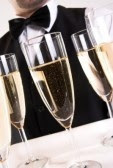I found this fascinating Facebook thread, prompted by a review in the Las Vegas Review-Journal of a $7.99-a-bottle Antinori Santa Cristina Sangiovese-Merlot blend, a hoot. Only the writers' surnames have been deleted.
THE REVIEW
In the glass: Santa Cristina wine is a deep garnet-red color with a fairly dense core going out into a lightly tinged rim definition with high viscosity.
On the nose: There are indicators that the famous terroir from which this wine's fruit is sourced shines through with powerful forward stewed red fruit dominated by ripe Morello cherries and cooked sloe fruit, with underlying notes of leather, plums, earthy minerals, herbs and dried red flowers.
On the palate: It is a nicely ripe and mature mouthful of wine right off the bat with red cherries, rhubarb compote, pomegranate juice and slightly rustic undertones, but all well-balanced. The midpalate and the supple finish confirm this with soft tannins and a pleasant lingering finish. It is medium-bodied in style and highly drinkable.
THE FACEBOOK THREAD
Mike: (His "headline") This wine costs eight bucks a bottle. How can it be this complex? What do red flowers taste like?
Mike: On the palate: It is a nicely ripe and mature mouthful of wine right off the bat with red cherries, rhubarb compote, pomegranate juice and slightly rustic undertones, but all well-balanced.
Linda: It's good stuff. My husband and I have been drinking it for years.
Mike: To be honest, I will be drinking a bottle of it in an hour. I like it a lot. But Christ..."slightly rustic undertones."
Mike: I take back the "red flowers" bit. The "red flowers" are on the nose, not on the palate.
Steve: A cheeky little wine but I perceive that you're amused by its presumption.
Mike: There you go...
Linda: It's a good wine, and very reliable from one bottle to the next, unlike most Chardonnays, which I find can vary a lot in quality.
Mike: Agree, Linda. And I get grossed out by bad reds...anything white is drinkable if cold enough (except Foxhorn). It's a great red for the money. But where do wine reviewers come up with this bullshit? Who has the taste of "rhubarb compote" so imprinted on their tastebuds that their palate can smoke it out in a glass of wine?
Linda: Oh, the reviews are BS, totally. And there have been studies where people doing wine tastings will claim, if they're given the prices of the various wines, that the more expensive ones taste better even if it's a cheap wine in an expensive bottle. So I always just go with what I like.
Mike: Yup. Oh, BTW, one of my friends is a beverage reviewer. He will no doubt show up here and set me straight bigtime.
Mike: Linda, I must say I agree with the viscosity angle. That's pretty obvious even to this hillbilly
Linda: Few things worse than a watery red, IMO. Another good one if you're looking for recommendations is Masciarelli Montepulciano d’Abruzzo. That's been our go-to red for a couple of years now, again, very reliable from one bottle to the next.
Mike: great...thanks...and a decent Zin for you: Cellar 8
Linda: Hm. I generally avoid zins because they're too fruity, but this sounds like one I'd like: "At first, the nose didn’t strike me as distinctly zinfandel. It was was mostly smoky and subtle. Given a chance to open up the zin characteristics ...
Mike: yes...not an overpowering zin. The pepper is nice...and you can't beat the farty nose
Bill (the aforementioned "beverage reviewer"): If I'm not mistaken, Farty Nose is a registered trademark.
Charlie: Can't go wrong with a pint of Guinness or a selection from Brown's in Troy.
Mike (a different one): Mike.. chill...when purchasing wine,those of us with a discriminating palate have learned to choose a box whose corners have been glued,not stapled
Christopher: Delicious is my favorite comment. Tastes good works also. Try the Sterling Meritage. Yummy. (Yummy is a good word!)
Lynn: Red flowers taste like.. Perfume.
Dan: I know what red flowers don't taste like...blue flowers.
John: best wine description I've read--noted that the wine tasted of road tar--and that was a good thing.
Mary Ellen: I like white merlot. It tastes like the stuff my Italian grandfather made in the cellar. That's a good thing.
Tim: Whatever happened to my early teenage years: "What's the word?" "Thunderbird!" "What's the price?" "Forty twice." Then my palate developing in early adulthood to the half-gallon bottle of Gallo Burgundy. Not too complex or balanced. But, Lord, what a drunk and a hangover I can still feel all these years later.
Mike (the original one): haha..had that. big thing when i was a kid: Ripple and Boones Farm. You could make ice cream floats with ripple, but they weren't very good
Tim: Oh, yes, Ripple too. Thunderbird was our white wine, Ripple our red. I'm too old for Boones Farm. I'd moved on to Lancers or Mateus.
Mike: the wine jingle i remember clearly from TV, Tim, was for something called Kings wine...had a king of diamonds on the front..."Get Kings wine...you'll be feeling real fine...." Forget all your cares and get...Kings wine." Yeah, i bet.
Dan: Well, I've forgotten all about Kings wine...it must have worked. My favorite out here was Spañada...it only came in gallon jugs.
To Dowd's Guide to American Wine Trails
To Dowd's Spirits Notebook latest entry.
To Dowd's Tasting Notes latest entry.
To Dowd's Brews Notebook latest entry.
Back to Dowd's Guides home page.


































